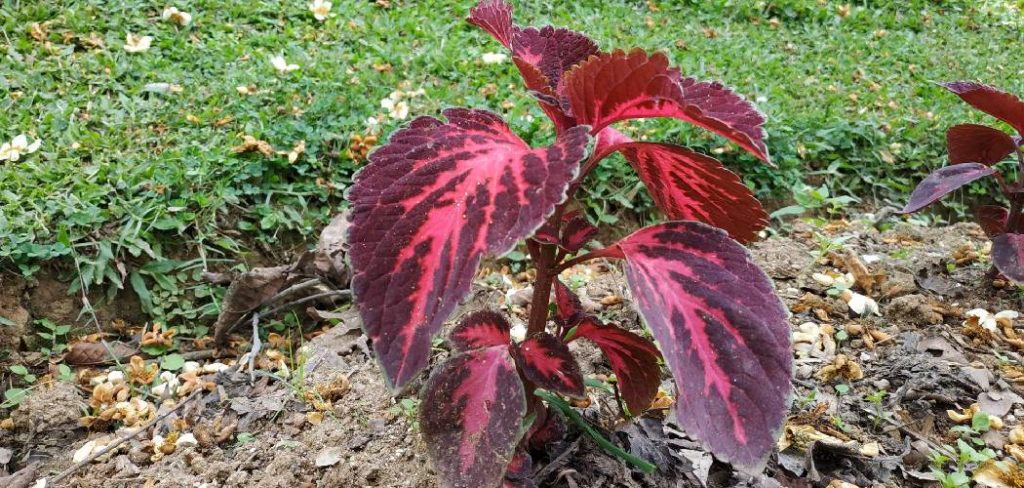Pruning coleus plants is an essential part of keeping them healthy, vibrant, and full of beautiful foliage. These low-maintenance plants thrive when properly cared for, and regular pruning encourages bushier growth while preventing them from becoming leggy. Whether you’re growing coleus indoors or in your garden, learning how to prune them correctly ensures they remain a striking addition to your space.

In this article on how to prune coleus plants, we’ll discuss the basics of coleus pruning and provide you with useful tips to keep your plants looking their best.
Why Prune Coleus Plants?
Pruning is essential for coleus plants as it helps them maintain a compact shape and prevents them from becoming leggy. When left unpruned, coleus plants can grow tall and spindly, losing their fullness and vibrant colors. This is because the plant’s energy is focused on growing upwards instead of filling out.
Additionally, pruning promotes airflow through the plant, reducing the risk of pests and diseases. It also encourages new growth, resulting in more foliage to enjoy. Removing damaged or diseased leaves also prevents the spread of any issues and keeps the plant healthy.
Best Time to Prune Coleus
The best time to prune coleus plants is during their active growing season, which typically spans from spring to early fall. During this time, the plant is producing new growth rapidly, allowing it to recover quickly from pruning. It’s advisable to begin pruning once the plant reaches about 6 inches in height to encourage a fuller, bushier shape.

Regular pruning throughout the growing season helps maintain the plant’s health and appearance. Avoid heavy pruning in late fall or winter, as the plant’s growth slows down during this period, making it more susceptible to stress and potential damage.
Tools and Materials Needed
- Clean, Sharp Scissors or Pruning Shears.
- Gloves (Optional, for Sensitive Skin).
- Disinfectant to Clean Tools (Prevent Disease Spread).
9 Step-by-step Guidelines on How to Prune Coleus Plants
Step 1: Prepare the Plant
Before you begin pruning your coleus plant, make sure it is healthy and well-hydrated. Water the plant a day in advance to reduce stress and ensure it can recover quickly after pruning. Inspect the plant for any signs of disease, pests, or damage, and identify the areas that need trimming.
This preparation step ensures both the plant’s safety and successful pruning outcomes.
Step 2: Remove Dead or Damaged Leaves
Carefully examine your coleus plant for any leaves that appear brown, yellow, or wilted, as well as those that show signs of damage or disease. Use clean, sharp pruning shears or scissors to gently cut these leaves off at the base of the stem.
Removing dead or damaged leaves not only improves the overall appearance of the plant but also helps redirect energy toward healthy growth. Always sanitize your tools before and after use to prevent the spread of disease.

Step 3: Cut Back Leggy Stems
Leggy stems can make a coleus plant look unbalanced and can hinder its growth. To address this, identify stems that have grown too long or appear sparse with leaves. Using clean, sharp pruning shears, trim these stems back to just above a leaf node or pair of leaves. This encourages the plant to grow fuller and bushier by promoting new growth from the trimmed areas.
Regularly cutting back leggy stems helps maintain the plant’s shape and ensures a robust and vibrant appearance. Remember to sanitize your tools before and after pruning for optimal plant health.
Step 4: Pinch off Flower Buds
For certain plants, pinching off flower buds plays a crucial role in encouraging healthier foliage and overall growth. When plants focus their energy on flowers, their foliage may become sparse or underdeveloped. By gently removing flower buds as they appear, you redirect the plant’s energy toward strengthening its leaves and stems.

To do this, use your fingers to carefully pinch off the bud at its base, or snip it with pruning shears if necessary. This practice is particularly important for herbs like basil or mint, where vigorous foliage growth is desired. Regularly inspecting your plants for flower buds and removing them early helps maintain their vitality and lushness.
Step 5: Fertilize
Providing your plants with the right nutrients is essential for healthy growth and productivity. Use a balanced, all-purpose fertilizer or one specifically formulated for the type of plant you are growing. Apply the fertilizer according to the instructions on the package, ensuring not to over-fertilize, as this can harm the roots and lead to weak, leggy growth.
For herbs and other edible plants, consider using an organic fertilizer to avoid introducing synthetic chemicals. Fertilizing regularly during the growing season will supply your plants with the nutrients they need to thrive, resulting in vibrant foliage and robust development.
Step 6: Monitor for Pests and Diseases
Regularly check your Coleus plant for any signs of pests or diseases. Common pests include aphids, spider mites, and whiteflies. If you notice any signs of infestation, treat the plant immediately with insecticidal soap or neem oil.
As for diseases, Coleus plants are susceptible to fungal infections such as powdery mildew and root rot. To prevent these diseases, make sure your plant is not overwatered and has good air circulation.
Step 7: Prune
Pruning helps maintain the shape and size of your Coleus plant. It also encourages bushier growth and prevents legginess.
Use sharp scissors or pruning shears to remove any dead or damaged leaves, as well as any stems that look weak or overcrowded. You can also pinch off the tops of new growth to promote branching.
Step 8: Repot
If your Coleus plant outgrows its current pot, it’s time to repot. Choose a pot that is slightly larger than the current one and has good drainage holes.
Use well-draining soil and gently remove the plant from its old pot, being careful not to damage the roots. Place the plant in the new pot and fill in any gaps with fresh soil. Water thoroughly.
Step 9: Fertilize
Coleus plants benefit from regular fertilization during their growing season (spring and summer). Use a balanced fertilizer or one that is high in nitrogen to promote leaf growth. Follow the instructions on the fertilizer packaging for application frequency and amounts.

Following these steps on how to prune coleus plants will help keep your plant healthy and happy. Remember to regularly check for pests and diseases, as well as maintain a consistent watering and fertilizing schedule. With proper care, your coleus plant will provide beautiful foliage year after year.
Additional Tips
- If you are propagating your coleus plants from cuttings, be sure to trim off any flowers that may appear. This will encourage the plant to focus on root growth instead of flower production.
- Consider using organic methods for pest control, such as neem oil or insecticidal soap, to avoid harmful chemicals on your plants.
- Some coleus varieties can also be grown in water rather than soil. Follow the same steps for pruning and repotting into water instead.
- Don’t forget to label your coleus plants with the variety name or type for easy identification and care.
- In colder climates, consider bringing your coleus plants indoors during the winter. They make great houseplants and can add a pop of color to any room.
- Experiment with different combinations of coleus varieties in containers or garden beds for a unique and colorful display.
- Remember to regularly fertilize your coleus plants, especially if they are grown in containers where nutrients can become depleted quicker. Use a balanced fertilizer every 2-3 weeks during the growing season.
- If you notice any leggy growth on your coleus plants, cut it back to encourage bushier growth.
- To prevent disease, make sure to provide good air circulation and avoid overwatering your coleus plants. Water when the top inch of soil feels dry.
- If you live in a colder climate, bring your coleus inside before the first frost and treat them as houseplants until spring returns.
- You can also propagate coleus plants by taking stem cuttings and rooting them in water or a moist potting mix. This is a great way to create new plants for yourself or to share with friends and family.
Frequently Asked Questions
Q1: Can Coleus Plants Thrive in Full Sun?
A: While coleus plants can tolerate some morning or evening sunlight, they prefer partial shade and can become damaged if exposed to too much direct sunlight.
Q2: How Often Should I Fertilize My Coleus Plants?
A: Coleus plants do not require frequent fertilization. It is best to use a balanced, water-soluble fertilizer every 2-3 weeks during the growing season.
Q3: Why Are My Coleus Leaves Turning Yellow?
A: Yellowing leaves can be a sign of overwatering, nutrient deficiency, or pest infestation. It is important to check the soil moisture levels and inspect the plant for any signs of pests.
Q4: Can I Overwinter My Coleus Plants Indoors?
A: Yes, coleus plants can be overwintered indoors as long as they receive enough light and proper care. You may need to prune back any leggy growth and reduce watering frequency during this time.
Conclusion
Caring for coleus plants can be a rewarding experience due to their vibrant foliage and adaptability. By understanding their basic needs, such as appropriate watering, light conditions, and occasional maintenance, you can ensure healthy and thriving plants.
Whether you choose to grow them outdoors during the warmer months or overwinter them indoors, coleus plants are a versatile and striking addition to any garden or home. Proper care and attention will allow you to enjoy their beauty for many seasons to come. Thanks for reading this article on how to prune coleus plants.
About
Jennifer Branett is a distinguished figure in the world of Garden design, with a decade of expertise creating innovative and sustainable indoor solutions. His professional focus lies in merging traditional craftsmanship with modern manufacturing techniques, fostering designs that are both practical and environmentally conscious. As the author of garden, Jennifer delves into the art and science of garden-fix, inspiring artisans and industry professionals alike.
Education RMIT University
(Melbourne, Australia) Associate Degree in Design (Jennifer Branett) Focus on sustainable design, industry-driven projects, and practical craftsmanship. Gained hands-on experience with traditional and digital manufacturing tools, such as CAD and CNC software.
Nottingham Trent University
(United Kingdom) Bachelor’s in Garden and Product Design (Honors) Specialized in product design with a focus on blending creativity with production techniques. Participated in industry projects, working with companies like John Lewis and Vitsoe to gain real-world insights.Publications and Impact
In indoor, Jennifer Branett his insights on Garden design processes, materials, and strategies for efficient production. His writing bridges the gap between artisan knowledge and modern industry needs, making it a must-read for both budding designers and seasoned professionals.
